<< Previous | Displaying results 4701-4725 of 6769 for "" | Next >>
Aerial view of the Nuremberg Palace of Justice, where the International Military Tribunal tried 22 leading German officials for war crimes. Nuremberg, Germany, November 1945.
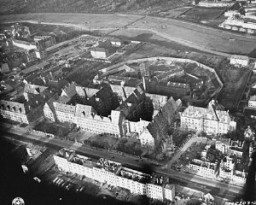
During the Nuremberg Trial, American guards maintain constant surveillance over the major Nazi war criminals in the prison attached to the Palace of Justice. Nuremberg, Germany, November 1945.
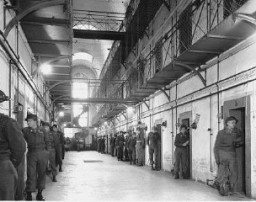
Survivors of Mauthausen cheer American soldiers as they pass through the main gate of the camp. The photograph was taken several days after the liberation of the camp. Mauthausen, Austria, May 9, 1945.
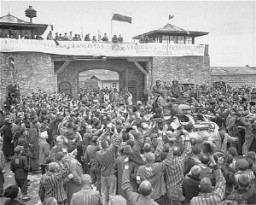
Members of a resistance organization in the camp meet with American soldiers in front of the entrance to the Buchenwald concentration camp. Buchenwald, Germany, after April 11, 1945. In early April 1945, as US forces approached the camp, the Germans began to evacuate some 28,000 prisoners from the main camp and an additional several thousand prisoners from the subcamps of Buchenwald. About a third of these prisoners died from exhaustion en route or shortly after arrival, or were shot by the SS. The…
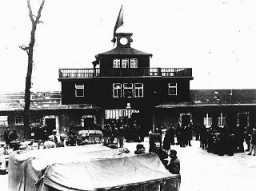
US soldiers enter the Buchenwald concentration camp following the liberation of the camp. Buchenwald, Germany, after April 11, 1945.
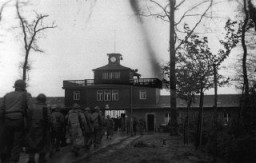
Prisoners carrying bowls in the Dachau concentration camp. Dachau, Germany, between 1933 and 1940.

Roll call at an internment camp for Roma (Gypsies). Lackenbach, Austria, 1940–41.
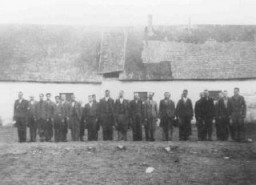
Prisoners of the Stupki forced-labor camp for Jews in the Generalgouvernement. Stupki, Poland, 1941–42.
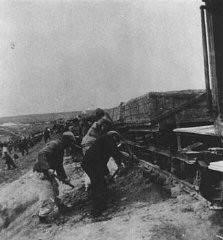
Prisoners at forced labor near the entrance to the Buchenwald concentration camp, Germany, 1937–45.

Prisoners at forced labor digging a drainage or sewage trench in Auschwitz. Auschwitz, Poland, 1942–43.
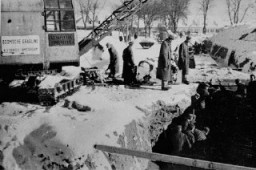
Fleeing the advance of the Soviet army, the Germans forcibly evacuated westward by barge these prisoners of the Stutthof concentration camp. Near Danzig, January 1945.
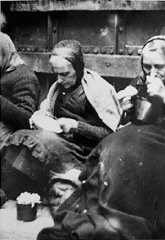
Crowds gathered in the streets of Tel Aviv celebrate the anniversary of the establishment of Israel with an independence day parade. Tel Aviv, Israel, May 1949.
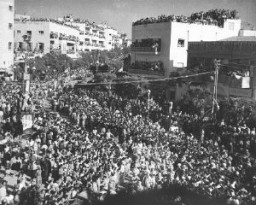
Members of a Polish family who hid a Jewish girl on their farm. Zyrardow, Poland, 1941-1942.
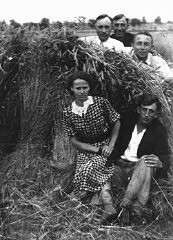
Photograph of a group of Jewish partisans. Sumsk, Poland, date uncertain.
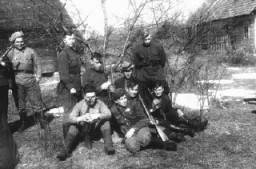
Jewish partisans, including a song and dance group, in the Naroch forest in Belorussia. In addition to armed resistance, Jewish resistance also focused on spiritual resistance—the attempt to preserve traditions and culture. Soviet Union, 1943.
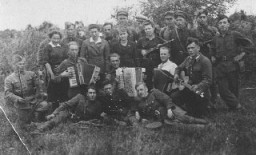
Group portrait of a Jewish French underground group named "Compagnie Reiman." This photograph was taken after the liberation of France. Paris, France, 1945.
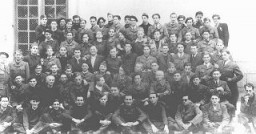
Yugoslav partisans with Jewish parachutists from Palestine. Yugoslavia, 1944.
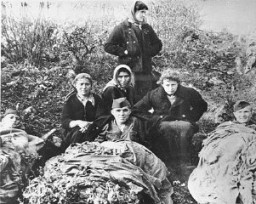
Deportation of Jews from the Warsaw ghetto. Jews from the ghetto board a deportation train with the assistance of Jewish police. Warsaw, Poland, 1943.
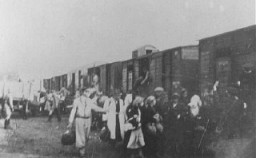
Juergen Stroop (third from left), SS commander who crushed the Warsaw ghetto uprising. Warsaw, Poland, between April 19 and May 16, 1943.
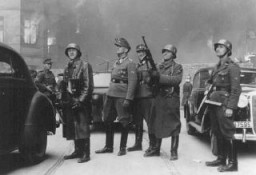
German soldiers capture Jews hiding in a bunker during the Warsaw ghetto uprising. Warsaw, Poland, April–May 1943.

Crematorium 4 under construction. This crematorium was later destroyed during an uprising in the camp. Auschwitz-Birkenau, Poland, winter 1942-1943.
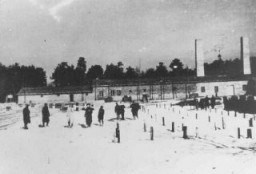
Modern techniques of propaganda—including strong images and simple messages—helped propel Austrian-born Adolf Hitler from being a little known extremist to a leading candidate in the 1932 German presidential elections. The style of this poster is similar to some of film stars of the era. Election poster, 1932; photo by Heinrich Hoffmann
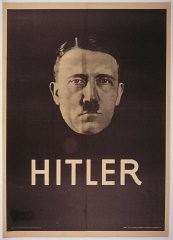
Hitler carefully cultivated his image as the Nazi Party leader as he came to see the propagandistic value of photographic publicity. Heinrich Hoffmann, Hitler’s official photographer, created the images central to the growing "Führer cult." In 1927, Hoffmann snapped action shots such as this one of Hitler rehearsing his oratory.

Poster: "Greater Germany: Yes on 10 April" (1938). This election poster emphasizes the message of jumping on the Nazi political bandwagon, as represented by the hands raised in a unified Nazi salute. Nazi propaganda frequently stressed the power of a mass movement to propel the country forward, subtly underscored by the upward angle of the hands. This poster typifies the propaganda strategy of using simple confident slogans, with bold graphics often using the characteristic Nazi colors of red, black, and…
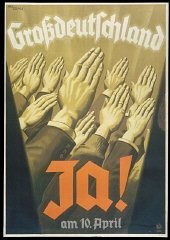
Poster: "We Women Are Voting Slate 2 National Socialists." German women were an important voting bloc. The Nazis made a concerted effort to appeal to women, as exemplified by this 1932 election poster. The Nazis had to repackage their messages to de-emphasize military aims. Hitler consciously modeled some Nazi propaganda appeals to German women on speeches delivered by Benito Mussolini in Fascist Italy, who also had to calm the fears of Italian war widows after World War I. Nazi propagandists attempted to…
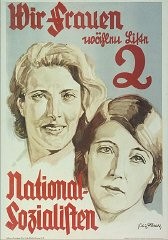
We would like to thank Crown Family Philanthropies, Abe and Ida Cooper Foundation, the Claims Conference, EVZ, and BMF for supporting the ongoing work to create content and resources for the Holocaust Encyclopedia. View the list of donor acknowledgement.